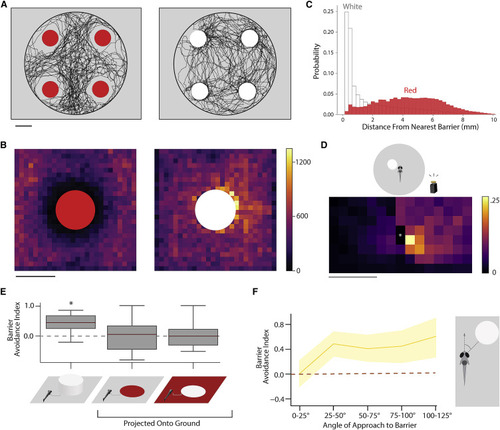Fig. 3
- ID
- ZDB-FIG-230509-30
- Publication
- Zwaka et al., 2022 - Visual object detection biases escape trajectories following acoustic startle in larval zebrafish
- Other Figures
- All Figure Page
- Back to All Figure Page
|
Figure 3. Red barriers are aversive and white barriers attractive, but both are avoided during escape (A) Example trajectories of a zebrafish freely swimming in the arena with four red barriers (left) or four white barriers (right; N = 6, 6). (B) Total visits to each spatial bin surrounding red and white barriers. (C) Distribution of distances from the nearest barrier edge for fish routinely swimming among white and red barriers. Bin size is normalized to the area occupied by each distance. These are the same data that were used to generate the 2D histograms in (B) except a vector is calculated from each coordinate the fish occupies to the nearest barrier edge. Fish coordinates (pooled) are significantly closer to white barriers versus red barriers during routine swimming (p < 2.2e−308, Mann-Whitney U on coordinate magnitudes). The most common distance fish occupy in white conditions is 0.25 mm from barriers, whereas red is 6.34 mm (modes). (D) 2D histogram depicting probability of the escape trajectory passing through a spatial bin for white barrier conditions. White asterisk indicates starting position of the fish (N = 19, n = 254). (E) Average barrier avoidance index for white physical barriers (p = 2.67e−5) and barriers projected onto the floor (N = 19, 20, 20; n = 254, 160, 146). Medians are indicated in red and boxes indicate the interquartile range. (F) Barrier avoidance index for different angles of approach to the white barrier in the light (yellow). As with red barriers, escapes are not biased in the frontal 25° of visual space. Solid lines represent mean and shaded areas 95% CI via bootstrap. Scale bars, 12 mm (A and B) and 1.25 mm (D). |

